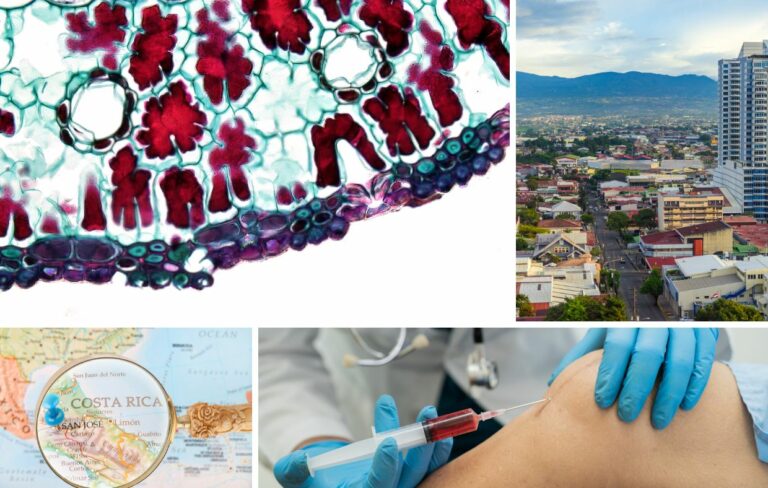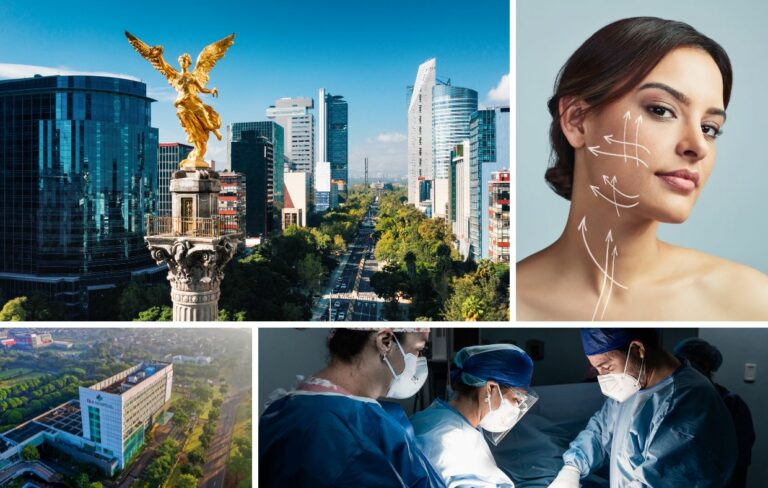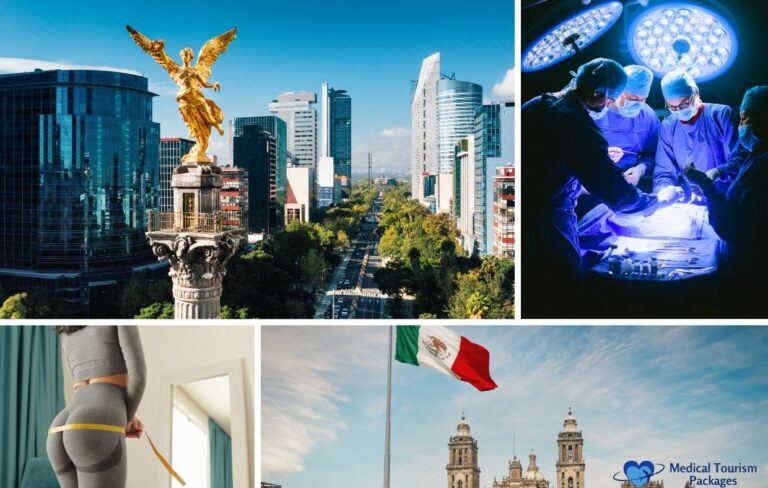Book Appointment Now
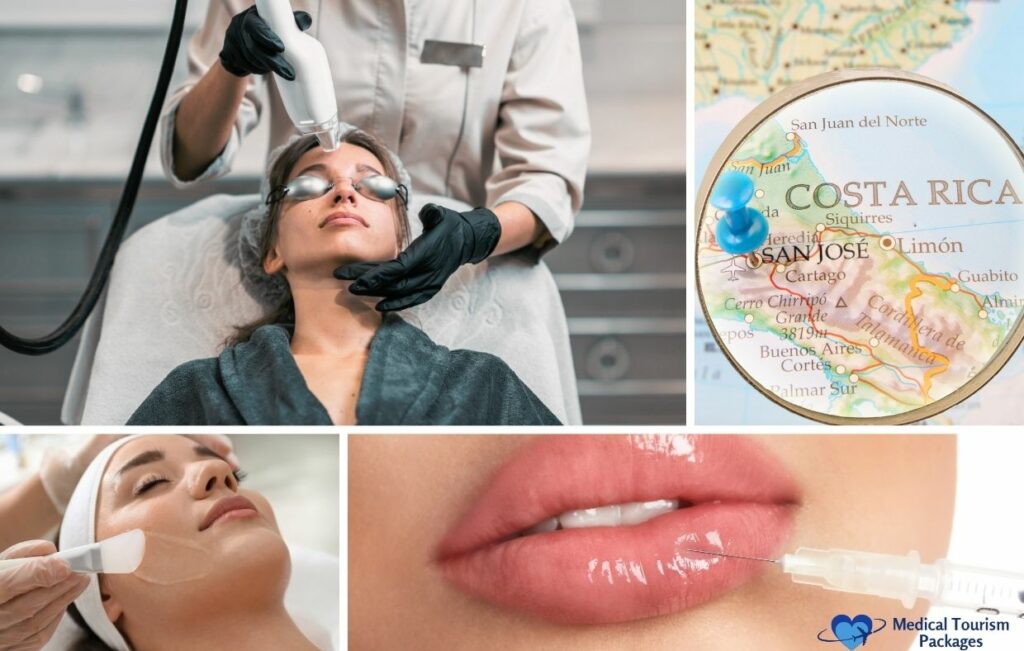
Botox in Costa Rica: Complete Guide to Costs, Clinics, and Treatment
Costa Rica has become a leading destination for cosmetic procedures, with Botox treatments among the most popular services for international patients. The combination of significantly lower costs, experienced practitioners, and the opportunity to recover in a tropical setting makes it an attractive option for those considering injectable treatments.
This guide covers everything you need to know about getting Botox in Costa Rica, from pricing and safety standards to choosing qualified providers and planning your medical tourism trip.
What is Botox Treatment in Costa Rica?
Botox is a neurotoxin injection that temporarily relaxes facial muscles to reduce the appearance of wrinkles and fine lines. The treatment works by blocking nerve signals to specific muscles, preventing them from contracting and creating creases in the skin. Most patients use Botox to address forehead lines, crow’s feet around the eyes, and frown lines between the eyebrows.
Costa Rica has built a substantial medical tourism industry around cosmetic procedures. The country attracts over 70,000 medical tourists annually, contributing approximately $437 million to the national economy. Cosmetic surgery accounts for about 25% of these cases, making it the second most common procedure type after dental work at 42%.
Botox serves as the primary entry point for aesthetic treatments in Costa Rica, mirroring global patterns where it remains the most requested non-surgical cosmetic procedure worldwide. The treatment appeals to patients because it requires no downtime, produces visible results within days, and costs significantly less than in North America or Europe. Women receive 85.1% of all Botox procedures globally, creating a 6:1 gender ratio, though male patients are steadily increasing.
How Much Does Botox Cost in Costa Rica?
Patients from the United States and Canada typically save between 40% and 70% on medical procedures in Costa Rica. The average Botox treatment costs approximately $375 USD in Costa Rica versus $600 USD in the United States which is a discount of over 37%. The actual price depends on the number of units required and specific treatment areas.
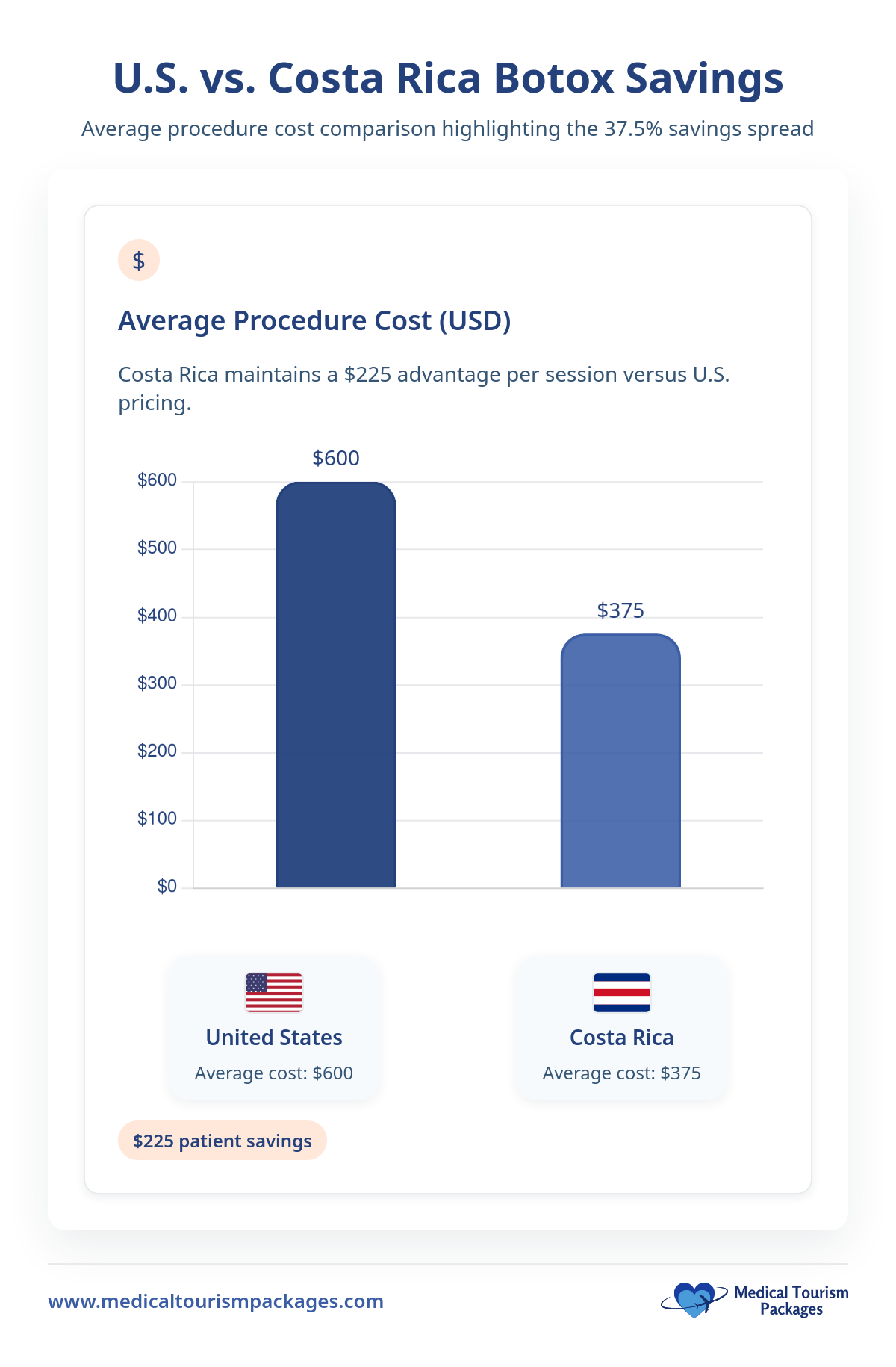
The Costa Rican medical tourism market was valued at $289 million in 2024 with a projected compound annual growth rate of 19.12% through 2033, reflecting increasing international confidence in the country’s medical infrastructure.
Cost Comparison by Treatment Area
| Treatment Area | Units Required | US Average Cost | CR Average Cost | Costa Rica Savings |
| Crow’s Feet | 12-24 units | $180-$360 | $108-$216 | 40% |
| Forehead Lines | 10-30 units | $150-$450 | $90-$270 | 40% |
| Glabellar Lines | 15-25 units | $225-$375 | $135-$225 | 40% |
| Full Upper Face | 40-60 units | $600-$900 | $360-$540 | 40% |
Several factors contribute to lower costs. Executive Decree 43291-S, effective February 2022, reduced cosmetic registration procedures from 25 days to one day, streamlining supply chains. Labor costs and operational expenses are substantially lower than in the US. However, many surgeons carry minimal or no malpractice insurance, which reduces their costs but shifts risk to patients.
Hidden Costs to Consider
The advertised treatment price doesn’t reflect total medical tourism costs. Budget for these additional expenses:
- Recovery accommodation: $80-$150 per night
- Emergency medical insurance: $50,000 minimum coverage required
- Medical evacuation insurance: $100,000-$1,000,000 recommended
- Actual evacuation costs without insurance: $50,000-$100,000
- Round-trip airfare, ground transportation, meals, and lost wages
Is Getting Botox in Costa Rica Safe?
Safety depends heavily on which clinic you choose. Costa Rica’s top-tier medical facilities meet international standards. CIMA Hospital holds Joint Commission International (JCI) accreditation, confirming adherence to US-level patient safety protocols. The Ministry of Health oversees all facilities, and Executive Decree No. 34482-S mandates that products meet FDA and EU guidelines.
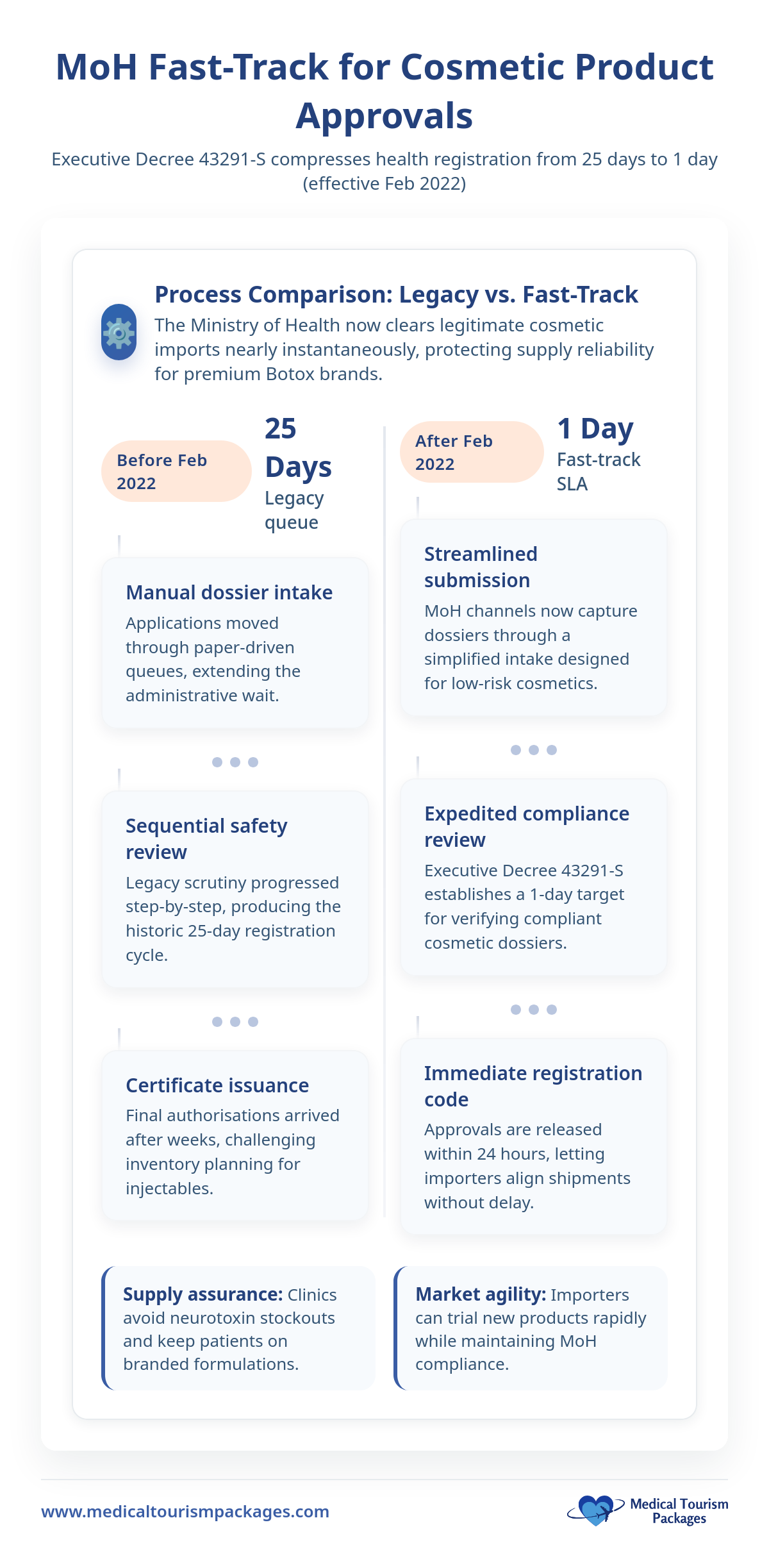
Botulinum toxin is classified as Biomedical Equipment and Material (EMB) and regulated according to sanitary risk level. Health registration is required for importation and distribution of all cosmetic products. However, enforcement varies significantly because accredited hospitals maintain strict compliance while smaller operations may not follow the same standards.
Key Risks of Medical Tourism
Medical tourism carries inherent risks absent in domestic treatment:
- Documented complications: Medical literature includes cases of Nontuberculous Mycobacteria infections from procedures abroad, requiring months of specialized antibiotic therapy.
- Zero insurance coverage: Standard US health insurance won’t cover elective procedures performed abroad or resulting complications during your trip.
- Follow-up difficulties: Coordinating care with Costa Rican providers after returning home creates delays and communication barriers. Your US physician must treat a procedure they didn’t perform without complete records.
Where Can You Get Botox in Costa Rica?
The clinical landscape for high-end aesthetic procedures concentrates in the metropolitan area surrounding San José, particularly the upscale Escazú district. The most reputable facilities operate within or are affiliated with large hospitals like the CIMA Hospital Office Complex. These hospital-affiliated practices benefit from immediate emergency access if complications arise.
Clinic Locations and Types
| Location | Clinic Types | Distance from Airport | Best For |
| San José/Escazú | Hospital-based, high-end clinics | 20-30 minutes | Maximum safety, JCI-accredited options |
| Tamarindo | Medical spas, satellite centers | 4 hours | Beach recovery vacation |
| Jacó | Mixed clinics and spas | 1.5 hours | Quick beach getaway |
| Manuel Antonio | Tourist-focused centers | 2.5 hours | Nature and beach combination |
Specific examples include the Plastic Surgery Center of Costa Rica and Clinica Rivera in San José, which cater specifically to international patients with English-speaking staff familiar with medical tourism logistics.
Smaller medical spas in coastal tourist areas like Tamarindo, Jacó, and Manuel Antonio cater to recovery vacation demand but may lack hospital resources and have variable practitioner training levels.
How to Verify Clinic Credentials
To verify clinic credentials, just follow our handy verification checklist.
Verification Checklist:
- Check for JCI accreditation (highest international standard)
- Verify physician’s license with Colegio de Médicos y Cirujanos de Costa Rica
- Confirm listing in National Registry of Aesthetic Practitioners
- Request before/after photos from previous patients
- Ask for patient references from your country
- Verify 3+ years of operation
- Confirm English-speaking staff availability
- Check multiple online review sources
Reputable clinics expect these questions and provide verification without hesitation.
Who Can Legally Perform Botox Injections in Costa Rica?
Only licensed physicians can administer Botox in Costa Rica as nurses and aestheticians are legally prohibited. However, training levels vary significantly among licensed doctors.
Provider Qualifications Comparison
| Provider Type | Training Required | Years of Study | Recommended For |
| Plastic Surgeon | 4 years general + 4 years plastic surgery | 14 years total | Complex procedures, revision work |
| Dermatologist | 3-4 years dermatology residency | 10-11 years total | Botox and skin treatments |
| General Practitioner | Medical degree + aesthetic certification | 6-7 years + courses | Simple Botox only if experienced |
Many high-caliber Costa Rican physicians have sought advanced training in the United States or Europe. Look for Board Certification from the American Academy of Aesthetic Medicine (AAAM) or specialized Botox courses. Ask about annual procedure volume and years offering treatment.
What Types of Botox Are Available?
Costa Rican clinics offer the same FDA/EU approved botulinum toxin products available in the US. Always confirm which brand your clinic uses and ask to see sealed packaging before treatment.
Botulinum Toxin Brand Comparison
| Brand | Key Characteristics | Onset Time | Duration | Best For |
| Botox (Allergan) | Original, most studied | 3-5 days | 3-4 months | All areas, predictable results |
| Dysport | Wider diffusion | 2-3 days | 3-4 months | Larger areas like forehead |
| Xeomin | No complexing proteins | 3-4 days | 3-4 months | Patients with resistance concerns |
Common treatment areas include forehead lines, glabellar lines, crow’s feet, bunny lines, lip lines, chin dimpling, neck bands, and masseter muscles for jaw slimming. Non-surgical cosmetic procedures experienced a 42.5% increase over four years leading to 2024.
Popular combination treatments include hyaluronic acid fillers (Juvederm, Restylane), non-surgical skin tightening, chemical peels, and laser hair removal.
Treatment Process and Planning
Most Costa Rican clinics serving international patients offer virtual consultations. You’ll submit photos and medical history for a treatment plan and price quote. Many clinics use patient facilitators who coordinate appointments, transportation, and accommodations, though they work on commission from clinics.
Required Documents Checklist
- Valid passport (6+ months validity)
- Medical records and allergies list
- Previous Botox treatment records
- Travel medical insurance documentation
- Clinic confirmation and contact information
- Hotel reservations and return flight details
US and Canadian citizens don’t require visas for stays up to 180 days.
Treatment Day Timeline
- Airport pickup – Arranged transport from Juan Santamaría International Airport
- Clinic arrival – Complete paperwork and payment
- Final consultation – Review treatment plan with injector
- Botox procedure – 10-20 minute injection process
- Post-treatment instructions – Receive aftercare guidelines
- Return to accommodation – Rest following activity restrictions
- 24-hour check-in – Phone or in-person follow-up
Plan to stay at least 24-48 hours after treatment for monitoring. A 7-10 day trip allows you to see initial results (visible at 3-5 days) and enjoy vacation activities. The recommended stay for comfortable recovery and vacation integration is typically 7-10 days.
Combining Treatment with Vacation
Costa Rica’s ecotourism reputation allows patients to combine treatment with recovery in nature which is a strong “pull factor” for medical tourists. However, certain activities must be avoided initially.
Post-Botox Activity Restrictions
| Time Period | Must Avoid | Can Do |
| First 4 hours | Lying flat, bending over, touching face | Walking, sitting upright, light activities |
| First 24 hours | Exercise, hot tubs, saunas, alcohol | Sightseeing, dining, beach walks |
| First 48 hours | Facials, massage, intense sun | Most tourist activities, swimming |
| After 48 hours | No restrictions | All activities |
Costa Rica Medical Center Inn in Escazú offers 24/7 nursing care tailored for post-procedure patients.
Tourist Destinations by Distance from San José
| Destination | Drive Time | Safe to Visit After | Activities |
| Jacó/Herradura | 1.5 hours | Day 2 | Beaches, restaurants |
| Manuel Antonio | 2.5 hours | Day 3 | National park, wildlife, beaches |
| Arenal Volcano | 3 hours | Day 3 | Rainforest, wildlife (skip hot springs initially) |
| Tamarindo | 4 hours | Day 3 | Beaches, surfing after restrictions |
| Puerto Viejo | 4-5 hours | Day 3-4 | Caribbean culture, beaches |
Minimum trip: 5 days (arrival, treatment, monitoring, tourism, departure). Ideal: 7-10 days to see initial results and enjoy multiple destinations. The generous 180-day tourist stay benefits retirees or long-stay tourists combining multiple treatments with extended vacation.
Expected Results and Timeline
Botox doesn’t produce immediate results. Initial changes appear within 3-5 days as the toxin blocks nerve signals. Full effects develop over 10-14 days. During the first week, you may notice asymmetry as different muscles respond at varying rates which is normal and resolves as treatment takes full effect.
Results typically last 3-4 months, though first-time users often experience shorter duration. Regular users may find results last longer as muscles become trained to relax. Factors shortening duration include high metabolism, frequent muscle use, inadequate dosing, smoking, and excessive sun exposure.
The Botox segment’s growth is expected to track or exceed the overall medical tourism CAGR of 19.12%. The market is projected to reach $1,662.44 million by 2033.
If you need adjustments after returning home, traveling back for touch-ups isn’t cost-effective. Bring detailed documentation including brand used, units administered, and injection sites for your local provider. Reputable Costa Rican clinics should offer corrections for significant issues within 2-4 weeks but confirm revision policies before treatment.
Choosing the Right Provider
Provider selection is your most important decision. Quality differences between top-tier and lower-tier clinics are substantial, directly impacting safety and results.
Essential Questions to Ask During Consultation
- What is your JCI accreditation status?
- Where did the physician complete training?
- Do you have US or European certifications?
- Which specific Botox brand do you use?
- How many procedures are performed annually?
- What’s your complication rate and protocol?
- What follow-up care for international patients?
- Will English-speaking staff be available throughout?
Red Flags to Avoid
- Prices dramatically below market average (likely counterfeit products)
- Pressure tactics or aggressive sales
- Inability to provide credential verification
- Unclean or disorganized facilities
- Cannot clearly explain procedures and risks
- Located far from hospital facilities
- No online presence or reviews
- Evasive about product brands
Overly discounted deals correlate with increased complication risks in the lower-tier market.
Legal Protections and Insurance
Understanding legal rights before treatment abroad is essential. The landscape differs significantly from domestic care.
Insurance Coverage Reality
| Insurance Type | Coverage | Cost | Notes |
| US Health Insurance | None for elective abroad | N/A | May cover complications after return |
| Medical Tourism Insurance | Complications, evacuation | $150-400 | Essential, not optional |
| Travel Insurance | Usually excludes procedures | Varies | Read exclusions carefully |
| Costa Rican Provider | Often minimal/none | N/A | Major liability gap |
Standard US insurance doesn’t cover elective procedures abroad. Even serious complications requiring hospitalization won’t be reimbursed. Specialized medical tourism insurance is essential, providing emergency care, evacuation, and complication coverage.
A key structural flaw: many Costa Rican surgeons carry minimal or no malpractice insurance, eliminating crucial financial safety nets for patients.
If Something Goes Wrong
Legal recourse is extremely limited. Filing malpractice claims in Costa Rica requires local attorneys, with cases taking years and uncertain outcomes. US courts generally lack jurisdiction over foreign procedures.
Complications like atypical infections can lead to devastating long-term physical and financial consequences. You’ll bear the full burden of care costs, potentially exceeding any savings achieved abroad.
Purchase maximum medical tourism insurance with high evacuation limits. Document everything: consent forms, medical records, photos, and communications for potential claims.
Common Mistakes to Avoid
Choosing Based Only on Price is the most dangerous mistake. Rock-bottom prices often indicate:
- Counterfeit or improperly stored products
- Less-qualified practitioners
- Weak safety protocols
- No hospital affiliation or emergency equipment
The high variability in cost reduction indicates aggressive pricing to attract volume at the expense of safety. Evaluate total value: credentials, accreditation, product quality, communication, and hospital proximity.
Communication failures affect every stage from consultation through emergency response. Misunderstandings about goals, medical history, consent, real-time procedure communication, and aftercare instructions create serious risks.
Confirm English-speaking staff availability throughout treatment, not just initial contact. Test language capabilities during consultation calls. Consider bringing a bilingual companion if concerned.
Is Botox in Costa Rica Right for You?
The primary market consists of US and Canadian patients ages 40-65 with disposable income for regular treatments. You’re well-suited if you:
- Can stay 7-10 days without work constraints (retirees ideal)
- Have schedule flexibility (December-April dry season optimal)
- Already travel regularly or vacation in Costa Rica
- Accept reduced legal protection risks
- Have financial resources for potential complications
Who Should Avoid Medical Tourism
Seek local treatment if you have:
- Complex medical histories or autoimmune disorders
- Limited financial resources
- High anxiety about distance from home
- No previous Botox experience
- Inability to afford complication treatment
First-time recipients benefit from establishing baseline response domestically before committing to international treatment.
Future Trends
Emerging trends include topical botulinum toxin formulations to reduce procedural pain and the “frozen look.” Telemedicine expansion enables better pre-treatment consultation and post-treatment follow-up. Increasing competition may drive quality improvements but could also pressure prices downward, compromising safety in lower-tier markets.
The fundamental question remains: do 40% cost savings justify increased risk and reduced legal protection? For patients carefully selecting JCI-accredited facilities with qualified providers and comprehensive insurance, Costa Rica offers legitimate value. For others, domestic treatment’s peace of mind may be worth higher costs.
Success requires thorough research, realistic expectations, and acceptance that medical tourism inherently trades some safety and legal protection for savings. Choose hospital-affiliated facilities, verify all credentials independently, and never select providers based solely on price. With proper planning and qualified providers, Costa Rica can deliver quality Botox treatments at significant savings, but only if you understand and accept the inherent risks of seeking medical care abroad.
Get started today
Make your Costa Rica Botox trip effortless with our medical facilitation services—built for safety, clarity, and comfort. We handle everything end-to-end: pre-trip teleconsultations, credential verification with licensed physicians, scheduling at hospital-affiliated and internationally accredited clinics, and transparent quotes that specify brand, units, and all fees.
Your bilingual patient coordinator arranges airport transfers, hotel options near Escazú/San José medical hubs, and priority appointments, plus 24/7 support and a post-treatment check-in. We help you secure the right medical tourism and evacuation insurance, prepare your medical records and consent documents, and provide detailed aftercare instructions (including activity timelines), so you can enjoy light sightseeing while you recover.
You’ll leave with a complete treatment summary for your local provider, no guesswork, no hidden costs, just a streamlined, risk-aware experience that maximizes value without compromising standards.
Request your customized itinerary and all-inclusive quote today.
Frequently Asked Questions
How much does Botox cost in Costa Rica?
The average Botox treatment in Costa Rica is about $375 USD versus ~$600 in the United States (roughly 37–40% less). Typical area pricing at 40% savings: Crow’s feet (12–24 units) $108–$216 vs $180–$360; Forehead (10–30 units) $90–$270 vs $150–$450; Glabellar/frown lines (15–25 units) $135–$225 vs $225–$375; Full upper face (40–60 units) $360–$540 vs $600–$900. Final cost depends on units used and areas treated.
Why is Botox cheaper in Costa Rica?
Lower labor and operating costs and streamlined regulation reduce prices; Executive Decree 43291-S (Feb 2022) cut cosmetic product registration from 25 days to one, easing supply chains. Many surgeons also carry minimal or no malpractice insurance, lowering their overhead but shifting risk to patients.
Is getting Botox in Costa Rica safe?
Safety depends on the clinic and injector. Top facilities like CIMA Hospital (JCI-accredited) follow US-level standards; the Ministry of Health regulates products and facilities, but enforcement can vary at smaller operations. Choose hospital-affiliated clinics in San José/Escazú and verify credentials to minimize risk.
Who can legally inject Botox in Costa Rica?
Only licensed physicians are allowed to administer Botox; nurses and aestheticians are prohibited. Training varies: plastic surgeons (~14 years total), dermatologists (~10–11 years), and general practitioners (6–7 years plus aesthetic courses). Choose specialists for complex work; experienced physicians for routine Botox.
Where are the best places to get Botox in Costa Rica?
High-end, hospital-affiliated clinics cluster in San José/Escazú (20–30 minutes from the airport), offering maximum safety and JCI-adjacent options; examples include Plastic Surgery Center of Costa Rica and Clinica Rivera. Beach towns like Tamarindo, Jacó, and Manuel Antonio have spas and satellite centers but may lack on-site hospital resources and have variable training levels.
How do I verify a clinic’s credentials in Costa Rica?
Use this checklist: confirm JCI accreditation (or hospital affiliation); verify the physician’s license with the Colegio de Médicos y Cirujanos de Costa Rica; check the National Registry of Aesthetic Practitioners; request before/after photos and patient references from your country; verify 3+ years in operation; ensure English-speaking staff; and cross-check multiple online reviews. Reputable clinics provide proof readily.
What hidden costs should I budget for beyond the Botox price?
Include recovery lodging ($80–$150/night), emergency medical insurance (minimum $50,000 coverage), medical evacuation insurance ($100,000–$1,000,000 recommended; evacuation without insurance can cost $50,000–$100,000), round-trip airfare, ground transport, meals, and potential lost wages.
What does the treatment process look like and how long should I stay?
Most clinics offer virtual consults (photos + medical history) and coordinated logistics. Treatment day: airport pickup, clinic intake and payment, final consult, 10–20 minute injections, aftercare, and a 24-hour check-in. Stay at least 24–48 hours for monitoring; a 5-day trip is the minimum, while 7–10 days is ideal to see early results and enjoy travel. US/Canadian citizens can stay up to 180 days visa-free.
What brands of botulinum toxin are used in Costa Rica?
Clinics offer the same FDA/EU-approved products as in the US: Botox (Allergan, most studied; onset 3–5 days; lasts ~3–4 months), Dysport (wider diffusion; 2–3 day onset; ~3–4 months), and Xeomin (no complexing proteins; 3–4 day onset; ~3–4 months). Confirm the brand in advance and ask to see sealed packaging before treatment.
What can I do after Botox and when can I resume activities?
First 4 hours: avoid lying flat, bending over, or touching your face; walk and stay upright. First 24 hours: avoid exercise, hot tubs, saunas, alcohol; light sightseeing and dining are fine. First 48 hours: avoid facials, massage, intense sun; most tourist activities are OK. After 48 hours: resume all activities, following your injector’s guidance.
What risks and follow-up issues should medical tourists consider?
Documented complications include atypical infections (e.g., Nontuberculous Mycobacteria) requiring prolonged antibiotics; follow-up can be difficult once home, and your local doctor may lack full records. Minimize risk by choosing hospital-affiliated clinics, verifying credentials, confirming product brands, and obtaining detailed documentation of units, sites, and brand for your local provider.
What insurance and legal protections apply to Botox in Costa Rica?
US health insurance typically doesn’t cover elective procedures done abroad or complications during your trip. Many local providers carry minimal malpractice coverage, limiting recourse; malpractice claims in Costa Rica can take years with uncertain outcomes. Purchase dedicated medical tourism insurance covering complications and evacuation (high limits), read travel policy exclusions, and keep complete records and consents.

